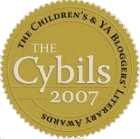Learning to Like Artemis Fowl
 When I sat down to read the nominees for the Cybils Award for graphic novels (elementary/middle category), I didn't expect to like Artemis Fowl: The Graphic Novel.
When I sat down to read the nominees for the Cybils Award for graphic novels (elementary/middle category), I didn't expect to like Artemis Fowl: The Graphic Novel.
I had read Eoin Colfer's original novel out of professional interest, never growing fond of it. That book was already a worldwide success, with sequels on its heels. In addition, as I wrote last year after helping to judge in the Fantasy category, in participating in the Cybils I hoped to be part of making a "discovery," helping to bring well deserved attention to a little-known book. An adaptation of a title that started getting international press even before it was published doesn't fit that bill.
Furthermore, it's clear that Artemis Fowl: The Graphic Novel was a corporate creation. As Publishers Weekly reported, Colfer took the idea of adapting his story into comics form to his publisher, Hyperion, part of Disney. The Editorial Director there accompanied Colfer to Accademia Disney in Milan, where they met artist Giovanni Rigano. To help with the script, the team then brought on Andrew Donkin, who started in comics (including one issue of Batman: Legends of the Dark Knight; no Robin) before writing prose books for kids. "With Colfer in Ireland, Donkin in London and Rigano and [colorist Paolo] Lamanna in Italy, the entire process was conducted through e-mail," said the magazine. So this book was created in the assembly-line fashion of the big comic-book publishers, with the resources of Disney behind it. I suspect that our culture, in coming to recognize comics as a literary art form rather than just pop entertainment, gives more respect to books created by people who fit our traditional model of the serious novelist or high-minded artist.
So this book was created in the assembly-line fashion of the big comic-book publishers, with the resources of Disney behind it. I suspect that our culture, in coming to recognize comics as a literary art form rather than just pop entertainment, gives more respect to books created by people who fit our traditional model of the serious novelist or high-minded artist.
That means author-illustrators who work alone, chasing their individual muses. Or at most a close working partnership of writer and artist. We imagine drawing boards set up in funky apartments, maybe even garrets. And we hope that process will produce something better than a market-driven collaboration of four established talents brought together by a worldwide entertainment conglomerate.
And yet, as I looked back on all five nominees in the Cybils' Elementary/Middle Grade Graphic Novel category, I ranked Artemis Fowl: The Graphic Novel at the top of my list. That assembly line had spat out a well-produced, entertaining, visually varied, and relatively complex comic.
TOMORROW: Why Artemis Fowl works as a comic book.


2 comments:
Not to pick nits, John, but I trust that in explaining why Artemis Fowl works as a comic book that you will help me understand better why I didn't like this as a graphic novel.
My analysis will be heavily informed by the work of Douglas Wolk, both in Reading Comics and in his recent comment to Publishers Weekly: “The question I got asked most often this year: ‘What’s the difference between “comics” and “graphic novels”?’ My answer: ‘The binding.’”
(And I want folks to notice the great effort I put into quotation marks there.)
Post a Comment